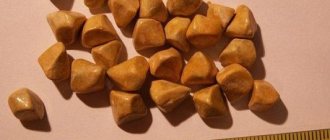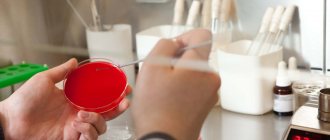Causes of yellow diarrhea
Before we talk about light yellow stool, let's define what diarrhea is in general. Diarrhea is a condition in which bowel movements occur more than twice a day and are accompanied by mushy or liquid stools. Feces with diarrhea can have different colors, yellowish feces are also found.
Normal human stool is shaped and multi-colored - from light brown to dark brown. Typically, the color of stool depends on the foods you eat. But lightening of the stool sometimes signals problems with the digestive system.
The most common causes of yellow diarrhea in adults:
- foods that lighten stool (fat dairy products);
- taking certain medications or vitamins;
- infections of viral or bacterial origin;
- helminthiases;
- lactase deficiency, a sign of which is yellow diarrhea after consuming dairy products;
- psycho-emotional stress (“bear disease”) is a common cause of diarrhea;
- surgical pathology – appendicitis, polyps, malignant and benign tumors;
- intestinal dysbiosis – a shift in microflora towards an increase in the number of opportunistic microorganisms;
- non-infectious diseases: Crohn's disease, enteritis, duodenitis, colitis, irritable bowel syndrome;
- diarrhea due to functional intestinal disorders, manifested by green-yellow stools;
- food allergies;
- stomach ulcer, sometimes accompanied by diarrhea;
- pathology of the liver, biliary tract;
- celiac disease - intolerance to gluten from cereals - wheat, rye, oats;
- pancreatitis, manifested by light diarrhea.
As you can see, liquid yellow stool occurs for various reasons.
Food
Most often, yellow stool in an adult is associated with people's taste preferences. Diarrhea usually appears after eating foods that are inappropriate for the stomach:
- Fatty foods - sour cream, butter. Animal fats are poorly digested. They enter the intestines almost in their original form, which causes yellow diarrhea.
- Light brown feces are due to the predominance of rice in the menu when losing weight.
- A similar result is observed if a person eats mainly potatoes.
- The diet of pregnant women, which includes a large amount of plant foods, also contributes to the occurrence of yellow diarrhea.
Excessive consumption of confectionery and sweets often causes diarrhea with light-colored stools in people suffering from gastritis.
Persons with low acidity of gastric juice are especially susceptible to diarrhea. Patients with hyperacid gastritis are more likely to suffer from constipation.
Taking medications
If the stool is yellow, the cause is often the use of medications:
- multivitamin complexes with ascorbic acid;
- oral contraceptives;
- non-steroidal anti-inflammatory and antipyretic tablets;
- fixatives for diarrhea;
- drugs used to treat tuberculosis;
- antibiotics that disrupt the balance of intestinal microflora - the cause of dysbiosis with diarrhea;
- antifungal agents.
After discontinuation of these tablets, the color of the feces is restored and the diarrhea stops.
Poisoning
Food poisoning with diarrhea most often develops after germs enter the stomach with food or water. Less commonly, they arise as a result of the action of poisons of mushrooms, plants, and berries. Bacteria, entering the stomach, multiply.
The toxins they release cause inflammation of the mucous membranes of the digestive tract.
Poisoning is recognized by the following signs:
- nausea;
- frequent vomiting;
- stomach ache;
- severe weakness.
Yellow diarrhea up to 3-4 times a day indicates damage to the upper parts of the small intestine. The stool becomes unformed, first mushy, then liquid.
Similar symptoms are typical for alcohol poisoning. The type of feces after a feast varies depending on the foods and drinks taken. In mild cases, a healthy person usually ends up with yellow water diarrhea. If streaks of blood are found in the stool, this may be a sign of ulcers or stomach erosions.
Gallbladder diseases
Pale yellow stool occurs due to liver and biliary tract diseases:
- Hepatitis is an inflammation of the main neutralizing organ of our body. The disease is manifested by increasing weakness, jaundice of the skin and sclera, and discolored diarrhea.
- Biliary dyskinesia is caused by the non-simultaneous entry of bile into the small intestine with food. Excess bile acids are the cause of bright yellow diarrhea in adults.
- Deformation of the gallbladder and ducts leads to a deterioration in their contractile function. As a result, a limited amount of bile enters the intestines. The feces become lighter.
- Cholecystitis is an inflammation of the gallbladder, which is characterized by a reduction in bile synthesis. The chronic disease occurs with bitterness in the mouth and belching. It is characterized by heterogeneous stools, which contain remnants of undigested fatty and plant foods.
- Blockage of the bile ducts is the direct cause of partial or complete cessation of bile secretion into the small intestine.
The appearance of beige feces in an adult is an alarming sign signaling a pathology of the hepatobiliary system. In most cases, this unusual color is caused by cirrhosis of the liver, viral hepatitis, and narrowing of the bile ducts.
Intestinal infections
Sand-colored feces often indicate fermentation in the intestines due to infections. The causative agent of the pathology can be salmonella, shigella, enteroviruses, E. coli and dysentery bacilli. But the leaders among the harmful army of the microcosm are rotavirus and staphylococcus.
During their life processes, bacteria and viruses release toxins that poison the liver.
Diseases are recognized by the following signs:
- endless nausea;
- frequent foamy stools 10–15 times a day with mucus;
- uncontrollable vomiting;
- pain in the stomach;
- elevated body temperature.
Foamy stool takes on a greenish tint. After some time, blood appears in the stool, which is especially typical for dysentery.
Possibly present diseases
The patient should closely monitor his well-being. Additional symptoms may indicate the course of the disease and dysfunction of certain organs. With yellow stool, it is difficult to establish the true cause of the deviation. A sign in an adult may indicate:
- viral and bacterial infections;
- food intoxication;
- infection with staphylococcus;
- helminthiasis;
- fungal disease;
- gastritis;
- inflammatory process in the pancreas;
- liver diseases;
- abnormalities in the functioning of the thyroid gland;
- intestinal disorders;
- intestinal colitis;
- hormonal disorders.
All of these deviations may have a similar clinical picture. It is for this reason that the patient needs a comprehensive diagnosis.
If you notice yellow stool, check your liver
Diseases of the pancreas are one of the most common root causes of yellow stools. In this case, there is a lack of enzymes in the adult’s body, which is required for the complete digestion of food. The walls of the small intestine are injured. An inflammatory process is formed. Patients often experience intense diarrhea.
When a malignant disease forms in the pancreas, a pathological narrowing of the bile duct occurs. Bile stops participating in the process of digesting food. For this reason, yellowish colored stool will appear. Food passing through the intestines injures its walls.
With a lack of bile, the following vitamins are no longer absorbed:
- A;
- D;
- E.
The skin becomes pale and dry. Skin rashes may occur. At night, visual acuity is greatly reduced. The body is exhausted and inflammation of the organs of vision occurs.
With a lack of essential vitamins and microelements, hair also actively falls out. The nail plate becomes brittle. The patient's appearance deteriorates.
Another common root cause of yellow stool color change is diseases of the small intestine. In this case, the body cannot digest food normally. Vitamins and microelements stop being absorbed. In adults, fecal matter moves faster through the gastrointestinal tract. The number of pathogenic microorganisms is increasing. The patient begins to complain of bloating, excessive gas formation and abdominal pain.
Sometimes the cause may be in the small intestine
Symptoms of yellow diarrhea in an adult
The picture of the disease develops in accordance with the cause that caused the diarrhea. Therefore, the appearance of yellow feces may be accompanied by various symptoms:
- arterial hypotension;
- tachycardia (increased heart rate);
- bloating;
- pale skin;
- steatorrhea (fat in stool);
- dry mouth;
- reduction in urine output;
- loss of consciousness.
Frequent vomiting and repeated diarrhea dehydrate the body.
Dehydration is a terrible symptom that is the cause of death from intestinal infection.
Pathologies affecting the color of stool
With various diseases, human stool may become completely yellow, or be light in color with bile.
Certain pathological conditions and diseases will affect the color of stool:
- Cystic fibrosis, acute or chronic pancreatitis, and other diseases of the pancreas.
- Weak functioning of the pancreas, expressed in the production of insufficient amounts of enzymes necessary for digestion.
- Hepatitis or cirrhosis of the liver.
- Fermentative dyspepsia.
- Compression of the bile duct (tumor of a neighboring organ or simply a pathological structure), causing stagnation of bile.
- Inflamed gallbladder.
- Biliary dyskinesia.
- Condition after removal of the gallbladder.
- Diabetes mellitus and other hormone-related diseases.
- Hormonal changes and temporary disruptions in the body during pregnancy, after childbirth or during menopause in women.
- Condition after surgery on any organs of the digestive tract.
- Chronic stomach disease - ulcers and gastritis.
- Crohn's disease causes total damage to the intestinal tract, due to which food is not fully absorbed and processed and the feces are discolored - clayey yellow.
- Nervous stress, especially with frequent mental fatigue.
Remembering what the normal color of an adult’s stool should be, you can immediately notice the slightest deviations and analyze what this change means. After all, changes in the color of feces depend on a lot, but if these are not harmless reasons (food, medications), then there is a possibility of developing a pathological process or even a disease from the list above.
One of the main causes of constipation or diarrhea is poor diet.
.
Therefore, to improve bowel function, you need to drink a simple drink
.
First aid for yellow diarrhea
In 99% of cases, food infections in healthy people go away on their own. The body's immune forces and normal intestinal flora cope with microbes.
Diarrhea with high fever and signs of dehydration requires calling an emergency team. While the doctors are on their way, take measures:
- Rinse your stomach the “restaurant” way. Give the patient 3-4 glasses of water at room temperature, then press on the root of the tongue to induce vomiting. Repeat the cleansing 2-3 times until you obtain clean rinsing water without food contamination.
- Give enterosorbent - 6 crushed tablets of activated carbon with water or 5 sachets of Smecta. You can use Polysorb, Enterosgel, Filtrum STI.
- The patient should regularly take saline solutions - Oralit, Regidron. After each episode of loose stools or vomiting, you should drink 100 ml of diluted pharmaceutical powder.
After taking the first measures for diarrhea, it is necessary to restore the water-salt balance. Natural mineral waters - Essentuki, Narzan, Smirnovskaya - replenish fluid volume well. Also drink bottled water in fractional doses every half hour, a glass until the thirst stops.
Attention! Do not use “borzhom” made from soda powder. The Ministry of Health of Estonia and Latvia has withdrawn Borjomi from sale. The European Union does not consider Borzh to be a natural mineral water, and therefore did not include it in the list of natural sources.
Treatment of yellow diarrhea
If the condition does not improve with diarrhea, medical attention is needed.
A gastroenterologist can make a diagnosis based on the color of the stool. Faeces with mucus indicate an intestinal infection. Bright yellow stool occurs due to pathology of the biliary tract. If diarrhea lasts more than 2 weeks, an intestinal tumor is suspected. Colonoscopy is used to confirm it.
Medicines
Initial therapy for diarrhea is the same in all cases:
- Solutions are administered to correct the water-salt balance and relieve intoxication.
- Preparations are used that contain lacto- and bifidobacteria (Linex, Acipol, etc.). By multiplying in the intestines, they stop diarrhea.
- Enzymes are used - Festal, Pancreatin.
- Antibiotics are prescribed only at the discretion of the doctor.
- For liver pathology, hepatoprotectors are used - Essentiale, Phosphogliv.
In the first days after poisoning, antidiarrheals are not used. The human body uses a protective mechanism to cleanse itself of bacteria and toxins.
Folk remedies
To consolidate drug treatment for diarrhea, medicinal herbs are used:
- Immortelle, yarrow or St. John's wort are infused in a water bath. The drug is prepared at the rate of 1 tbsp. l. herbs per glass of boiling water. After keeping on fire for 15 minutes, the solution is filtered and taken 50 ml three times a day before meals.
- Melissa has an anti-inflammatory effect on orange stools. Essential oils of this plant eliminate intestinal spasms. The infusion is prepared and taken in a similar way.
- Dill water relieves bloating in the stomach, reduces colic, and helps fight diarrhea. Place 1 tsp per glass of water. seeds, bring to a boil and remove from heat. After infusion for half an hour, take 1 tbsp. l. 4–5 times a day.
Herbal remedies alone will not eliminate diarrhea. They are used as part of complex treatment.
What does a change in stool color indicate?
Normally, an adult's stool is brown in color. But if the body is not functioning correctly, the color of the stool may change to light, white-yellow, clay gray, earthy, yellow-green, green-gray, sandy, tan, orange, dark orange, red or black. Multi-colored feces are not the norm, but they are quite rare; the most common color of altered feces is yellow.
Yellow poop in adults appears due to insufficient intake of the enzyme stercobilin, which is responsible for coloring poop, into the intestines. What color the stool will come out depends on the stercobilin produced by the liver; the less of it, the lighter the stool, and the more, the darker.
Yellow feces may be a reason to consult a doctor if the problem really lies in the malfunction of the liver, gall bladder, or pancreas - the organs responsible for the production of enzymes for digestion.
There is an option that an adult’s stool has changed to light-colored for natural reasons, which means there is nothing to worry about. But similar reasons for the appearance of yellow or yellow stool will be discussed below.
Photo:
One of the main causes of constipation and diarrhea is the use of various medications.
.
To improve bowel function after taking medications, you need to drink a simple remedy
.
Consequences
The most severe consequence of diarrhea, even death, is dehydration.
Its initial signs are dry lips and oral mucosa, lack of urine for 3 hours or more, severe thirst.
Another complication is poisoning of the body with toxins of bacteria and viruses with the development of toxic shock.
If diarrhea is caused by viral hepatitis, the person is poisoned by his own waste. Inflammation of the liver eventually transforms into cirrhosis.
Prevention
To prevent diarrhea with light yellow stool, take the following precautions:
- eliminate foods that irritate the intestines from your diet;
- wash fruits and vegetables with boiled water;
- adhere to basic sanitary standards in the kitchen;
- a mandatory requirement is personal hygiene.
Remember that intestinal infections and food poisoning are a disease of dirty hands . Following preventive recommendations prevents the appearance of yellow diarrhea in most people.
When is yellow stool normal?
Often, stool changes color when eating certain food groups in a sufficiently large volume. The situation, if the stool is yellow, may indicate the presence in the diet of a large amount of:
- peas;
- dairy food;
- brightly colored fruits.
Feces turn dark yellow in people who follow a vegetarian diet and eat too many plant foods. A change in the color of stool under the influence of this factor does not require any special treatment. It is recommended to simply exclude such products from the diet or reduce their quantity, which will prevent the occurrence of intolerance to the product due to its increased concentration in the body. In addition, it will help normalize the content of carbohydrates, proteins and fats entering the human body.
Some medications can change the color of stool, including antibiotics and contraceptives. In addition, anti-tuberculosis drugs and medications with laxative effects can affect the coloring.
In the event that it is impossible to refuse therapy with such medications, medications are prescribed whose action is aimed at restoring the gastric microflora. With their help, it is possible to reduce the aggressiveness of drugs intended to treat the underlying disease, but do not reduce their effectiveness.











